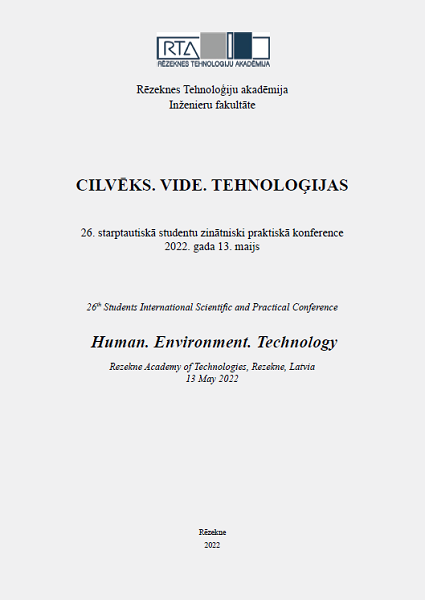POSSIBLE USE OF LASERS FOR CLEAVAGE OF PHENOLS TILL BASE SUBSTANCES (REVIEW)
DOI:
https://doi.org/10.17770/het2022.26.6961Keywords:
Bacteria, laser technology, phenol, wastewaterAbstract
The purpose of this review article is to explain the hazards of phenol and phenol compounds to human health and the environment. To describe where and how phenol and its compounds occur, especially in industrial effluents. To study the possibility of using laser technologies for phenol cleavage, as well as for the treatment of industrial wastewater from phenol compounds. Removal of phenol and its compounds using biological wastewater treatment process is widely used worldwide. This method is cost-effective and environmentally friendly. On the other hand, exceeding the tolerable phenol concentration, which is individual for each biological treatment plant, may result in severe intoxication and lead to death of activated sludge system. Thus, the biological treatment process of industrial wastewater is halted until the phenol concentration is reduced to an acceptable level and the microorganisms have time to recover. Such a procedure can be time consuming and unpredictable due to the susceptibility of microorganisms to changing conditions. Based on this, sources of literature have been studied that could help to understand which laser equipment can be used to cleave a phenolic compound or benzene ring to simpler compounds.Downloads
References
Chandana Lakshmi M.V.V., Sridevi V., A review on biodegradation of phenol from industrial effluents. https://www.icontrolpollution.com/articles/a-review-on-biodegradation-of-phenol-fromindustrial-effluents-.pdf
Mohammadi S., Kargari A., Sanaeepur H., Abbassian K., Najafi A., Mofarrah E. Phenol removal from industrial wastewaters: a short review. Pages 2215-2234. http://dx.doi.org/10.1080/19443994.2014.883327
Paula M. van Schie, Lily Y. Young. Review Article. Biodegradation of Phenol: Mechanisms and Applications. Pages 1-18 https://doi.org/10.1080/10588330008951128
Solyanikova I. P. and Golovleva L. A., “Bacterial degradation of chlorophenols: pathways, biochemica, and genetic aspects,” J Environ Sci Health B, vol. 39 (3), Pages 333-351
V. Bucci, S. Hoover and F. L. Hellweger, “Modeling Adaptive Mutation of Enteric Bacteria in Surface Water Using Agent-Based Methods,” Water Air & Soil Pollution, vol. 223 (5), Pages 2035-2049
Zhao L., Wu Q., Ma A. Paper: Biodegradation of Phenolic Contaminants: Current Status and Perspectives https://iopscience.iop.org/article/10.1088/1755-1315/111/1/012024
J. Rao, B. Nair, A. Rathinam, A. Giridhar and N. Nagiah, “Synergistic effect of pseudomonas aeruginosa and escherichia coli in the biodegradation of phenolic compounds,” Journal-American Leather Chemists Association, vol. 103 (7), Pages 222-226
https://en.wiktionary.org/wiki/nitrobacterium
Prosser J.I., in Encyclopedia of Soils in the Environment, 2005 https://www.sciencedirect.com/topics/agricultural-and-biological-sciences/nitrifying-bacteria
Amor L., Eiroa M., Kennes C., Veiga M.C. Phenol biodegradation and its effect on the nitrification process. DOI: 10.1016/j.watres.2005.05.019
Ward Bess B., in Nitrogen in the Marine Environment (Second Edition), 2008 https://www.sciencedirect.com/topics/agricultural-and-biological-sciences/nitrifying-bacteria
Wahman D.G., Pressman J.G., in Comprehensive Water Quality and Purification, 2014 https://www.sciencedirect.com/topics/agricultural-and-biological-sciences/nitrifying-bacteria
Gensen O M. Nitrate in drinking water and cancer in Northern Jutland, Denmark, with special reference to stomach cancer. Ecotoxicol Environ Safety. 1982;6:258–267.
Wilderer P A, Jones W L, Dau U. Competition in denitrification systems affecting reduction rate and accumulation of nitrite. Water Res. 1987;21:239–245.
Barak Y., Tal Y., Van Rijn J. Light-Mediated Nitrite Accumulation during Denitrification by Pseudomonas sp. Strain JR12. https://www.ncbi.nlm.nih.gov/pmc/articles/PMC106331/
Kim K., Park Y. G., Light as a Novel Inhibitor of Nitrite-Oxidizing Bacteria (NOB) for the Mainstream Partial Nitrification of Wastewater Treatment https://doi.org/10.3390/pr9020346
Siripattanakul S., Phenolic Based Pharmaceutical Contaminated Wastewater Treatment Kinetics by Activated Sludge Process, 2014 https://www.researchgate.net/publication/270768522_Phenolic_Based_Pharmaceutical_Contaminated_Wastewater_Treatment_Kinetics_by_Activated_Sludge_Process DOI:10.7763/JOCET.2014.V2.111
International Chemical Safety Cards (ICSCs). Phenol. [online] [reference to 10.05.2022.] Available: https://www.ilo.org/dyn/icsc/showcard.display?p_card_id=0070&p_edit=&p_version=2&p_lang=en
Laser applications. Laser marking. [online] [reference to 10.05.2022.] Available: https://www.mecco.com/application-laser-marking#:~:text=%E2%80%8BWhat%20is%20Laser%20Marking%3F&text=In%20simplest%20terms%2C%20laser%20marking,a%20wide%20variety%20of%20applications.


